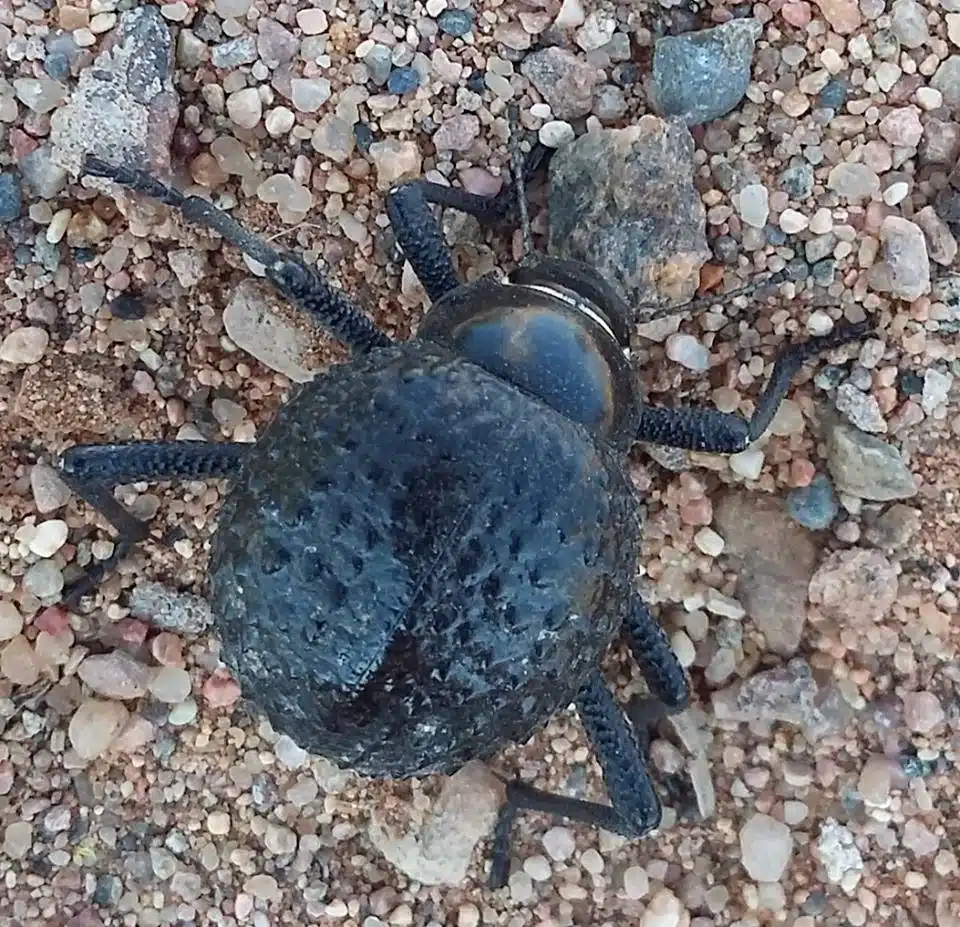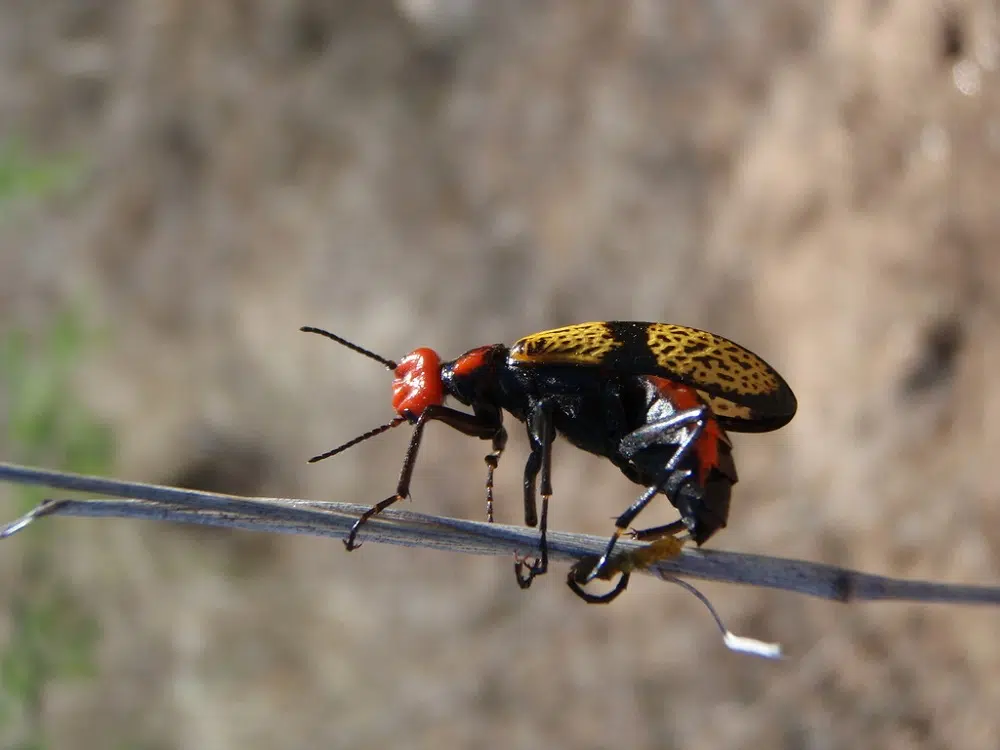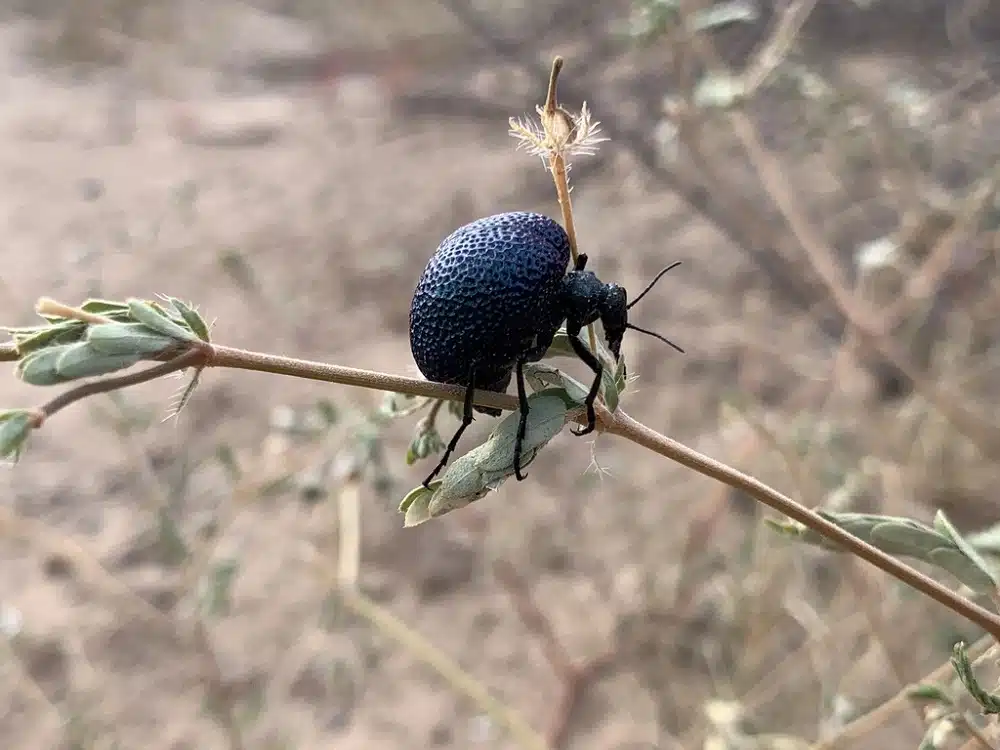Beetles are among the many unlikely species to live in the desert. Still, there are a few species that are even present in The Mojave and Colorado Deserts.
These bugs go to extreme lengths to survive here in the desert. These adaptations allow them to thrive either in rainy periods or throughout the year.
Table of Contents
Desert Beetle Adaptations
Only adaptable beetles can live in the desert. These adaptations include living fossorial lives as larvae or drafting water from the air when living on the coast.
Here are some of the most common ways beetles can survive in the desert.
Wax coating
A wax-like substance can be produced by different beetles such as those of The Asbolus family.
Wax coating means these bugs are less likely to be impacted by heat in terms of desiccation.
In some cases, the wax coating is very visible and may even come in a contrasting color as opposed to the color of the head or the elytra.
Collecting water from early morning fog
Rare types of beetles such as those in The Namib Desert can survive by collecting water from the fog.
They do so in the morning when they position themselves against the wind for the fog to form droplets on the elytra, often covered in wax.
These bugs are so good at collecting water that they even know how to bend their heads so that the formed droplets reach their mouthparts.
Eating cacti and tree sap
Food and vegetation sources are scarce in the desert. Beetles go to extreme lengths when it comes to food alone.
Cacti are among the most important food sources both for adults and for beetle larvae.
Some species survive in the desert as larvae by feeding on cacti roots, which impact their health and may even kill cacti.
Adults navigate various species such as prickly pear for food, especially in the absence of other food sources such as tree sap.
Boring into cacti roots
Boring deep into cacti provides food and moisture for beetle larvae.
Fossorial or underground living habits provide a shaded place for beetle larvae to turn into adults.
In some cases, the fossorial larval stage of beetles can last even up to 3 years.
Living in animal burrows
Most beetles live in some type of retreated location to keep away from the sun and their predators in the desert.
Rodent burrows and even bee nests in the ground are known places for beetles to live either as adults or as larvae.
Most beetles only hide under rocks or vegetation but those that live a longer life tend to move underground when not looking for food or to breed.
Mimicry
Some beetles are even known to rely on mimicry to keep predators of the desert away. They can mimic the species that release chemical defenses such as stink bugs that many predators are afraid of.
Here are some of the typical beetles found in American deserts and other deserts of the world.
Beetles in the Desert
Beetles live in deserts around the world. Here are some of the most common ones.
1. Desert Ironclad Beetle

A species of the Southwestern US desert, The Desert Ironclad Beetle (Asbolus verrucosus) is mostly known in the bug pet trade industry.
This species also lives in The Mojave Desert where its adaptations such as omnivore eating habits allow it to live a long life.
Plants and insects are eaten by this desert-adapted species. They show the capacity to eat opportunistically.
Unlike many other species, they also have a bright blue waxy substance covering the elytra.
The role of the waxy substance is to prevent extreme dehydration and to allow these bugs to live in arid climates such as those in deserts.
Growing to a maximum size of just over 0.8 inches, Desert Ironclad Beetles are almost completely blue as the waxy surface covers the elytra and the body.
2. Master Blister Beetle

While some beetles survive the desert by being omnivores, others survive the desert mostly by feeding on one plant alone.
Master Blister Beetles (Lytta magister) are among the species that only feed on brittlebush, a small type of shrub adapted to desert climates.

The Mojave and The Colorado Desert are both known for brittlebush and Master Blister Beetles.
These types of bugs are a bit larger than Desert Ironclad Beetles as they reach a size of up to 1.3 inches.
Red and black nuances offer the dual color appearance of these bugs which have a shiny black elytrum. The head is red while the antennae are black.
While adult bugs feed on vegetation, the larvae feed on insects and show a parasitic type of feeding.
3. Striped Fogcatcher Toktokkie

Some of the most extreme adaptations to desert climates allow Striped Fogcatcher Toktokkie (Stenocara gracilipes) to survive in this climate.
Even its name implies that this is a species that collects water from the air by harvesting early morning fog.
There’s a certain technique that allows this bug to do so. It places itself against the wind, in a slightly down-facing position to collect moisture from the air.
Fog turns to droplets when meeting a cool hard surface and this is what happens on its elytra.
The bug remains in this position until the droplet is large enough for it to move down toward its head and eventually toward the mouth.
This atypical species is further identified by its black-and-white color and by its presence in Africa’s Namib Desert.
4. Desert Toktokkie

Coastal regions of The Namib Desert are also home to The Desert Toktokkie (Physosterna cribripes).
This type of dark beetle is known for its wider elytra which is also covered in warts.
While it eats almost anything it can chew, this is a bug mostly known for its capacity to collect water from the air.
It waits for air currents from the ocean to blow towards the land early in the morning.
The moisture in the morning fog creates smaller and then larger droplets as they reach their waxy body.
Eventually, one large droplet makes it to its mouth as the bug bends head-down for it to slide down its head from its elytra.
Its capacity to work together with morning fog for water means these bugs aren’t dependent on rain as other species of the desert with a more sporadic appearance.
5. Pitted Beetle

An all-black beetle, Pitted Beetles (Adesmia cancellata) have a distinct appearance with dimple-like protrusions of the elytra.
They are among the most resilient species of bugs in The Middle East and are well-adapted to desert conditions.
Enjoying a high speed of movement tops its list of adaptations.
These bugs are very fast and generally come out for food briefly, shortening their time in direct sunlight which further reduces the risk of desiccation.
Living among desert shrubs, the species tends to hide under rocks or vegetation most of the day.
6. Figeater Beetle

A species of the US deserts, Figeater Beetles (Cotinis mutabilis) grow to a size of just over 1 inch and are a common species even in gardens, outside of the desert.
This is a species that survives deserts by crawling and feeding on different types of cacti.
Its adaptations to cacti-eating even include its appearance as Figeater Beetles are mostly green.
This is a species that shows a dark green appearance with a few yellow marks on the sides.
Its diet isn’t based on cacti alone. These bugs may also eat the sap of various shrubs and trees in their range.
Once adults, they can eat fruit and even large fruit in gardens.
Figeater Beetle larvae have different dietary preferences as they prefer decomposing plants.
7. Giant Cactus Longhorn Beetle

Identified by their all-black appearance, Giant Cactus Longhorn Beetles (Moneilema gigas) are known for their fused wings across the elytra.
This is a species impacted by cacti such as prickly pear throughout its life.
Both adults and their larvae are dependent on these cacti for food. Adults cannot fly and they feed on cacti as they move along their spikes.
Their larvae bore deep into the cacti, even eating their roots. Too many of these bugs may even kill cacti.
While adapted to desert conditions, Giant Cactus Longhorn Beetles do seem to be more active in the rainy season.
8. Armored Stink Beetle

Armored Stink Beetles (Eleodes armata) are among the common black beetles in the deserts of the Southwestern United States.
These bugs have an all-black appearance and they move fast across the sand.
Larvae of Armored Stink Beetles are fossorial which means they grow and develop underground.
The species mostly inhabits an area around the US-Mexico border, Armored Stink Beetles are named after their chemical defenses.
This is a species that can release a foul smell just to keep predators away.
Larvae of these bugs may also be detrimental to some of their host plants as they feed on the roots of different cacti and shrubs.
9. Palo Verde Root Borer

This species (Derobrachus hovorei) has a distinct elongated appearance with a common dark color. Almost all-black, the species has elongated antennae and a long elytra.
Much of its early years are secretive as Palo Verde Root Borers spend their lives underground.
They live and feed underground and their feeding habits can be highly detrimental to the plants whose roots they chew on.
Also found in the US deserts and around the US-Mexico border, Palo Verde Root Borers are detrimental to citruses in their first years.
It can take up to 3 years for these bugs to emerge.
During this time, they impact the roots of citruses. In other areas, these bugs can be just as detrimental.
Even hardwood tree roots can be impacted to the extent of partially killing a host tree when these bugs start chewing on its roots.
10. Dentate Stink Beetle

This type of black bug (Eleodes dentipes) is distinguished by its wider joined elytra and its all-black appearance.
A species of the Southwestern US desert, Dentate Stink Beetles are known for their preference for plants and dead plants.
These bugs aren’t seen during the day as adults hide under rocks or crawl in shaded places such as rodent burrows.
Dentate Stink Beetles also have long worm-like larvae that develop in the ground.
It’s here that the larvae are shaded from the sun and where they can feed on various plants.
As their name implies, these bugs can also release a foul chemical smell onto their predators, mainly by raising their rear end and pointing.
11. Inflated Beetle

Inflated Beetles (Cysteodemus armatus) are named after their inflated globular elytra which seems to cover the entire body.
Endemic to The Mojave Desert, Inflated Beetles have black spots on the elytra, in all of their color variations.
These bugs show parasitic traits and means of survival, especially when it comes to their larvae.
Inflated Beetle larvae are mostly parasitic on bee nests. The bees that nest solitarily underground are the most likely to be impacted by their larvae.
Once emerge as adults, these bugs may be spotted in rocky areas of the deserts on the ground alone, as they cannot fly.
12. Iron Cross Blister Beetle

Iron Cross Blister Beetles (Tegrodera aloga) are among the few bugs with a cross on them that live in the desert.
A black cross is seen on the elytra which is mostly yellow while its head is red-brown.
These bugs survive in the desert by feeding on the various local flowering plants they can find.
Highly aggressive, Iron Cross Blister Beetles are also known to be among the few bugs of the desert that fight among them.
Males fight other males for breeding rights and they can injure themselves in these confrontations.
13. Black Bladder-bodied Meloid

A bulbous species of the Southwestern US deserts, Black Bladder-bodied Meloids (Cysteodemus wislizeni) are bugs that can even bite humans.
These bugs have a round shape and a green-blue metallic appearance with an inflated elytra.
Small grooves are seen across its elytra which is at least a few times larger than its head.
Bugs of the species can produce a poisonous substance when under threat. This makes many of their predators sick and eventually learn to stay away.
Black Bladder-bodied Meloid bugs are also known to cause blisters when handled.